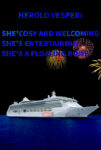The author says:
Title: She’s cosy and welcoming. She’s entertaining. She’s a floating bomb.
Subjects: Safety in the cruise industry. Big risks taken by the management encouraged by the cheap money from the financial system. An industry forced to cope with the fossil fuels depletion.
Setting: No precise setting, but a big chunk of the book is dedicated to the sinking of the Costa Concordia which happened in Italy. Style: journalistic approach by a non expert who spent several months collecting information and browsing all the resources. It includes a lot of commentary on the view of the facts presented by the current media overall.
Book presentation on the online publishing platforms: A critical view of the cruise industry. An analysis that takes into account the economical, political and technical side of the problem and shows the inherent dangers carried by the business driven choices that affect the design of the new ships. Compounded by a critical view of the image that we get from a subservient media. Through a review of the way the events of the past were reported and how the stories are still told today this work underscores the weaknesses and the faults that were not meant to be seen by the public, it shows how confusion and misleading reports managed to hide all those flaws and weaknesses in plain sight. It also underscores the lessons that have never been learnt because the business cannot afford to learn while they chase the myth of eternal growth. The result of the frantic search for endless growth can be seen in the huge debts that weigh heavily on the accounting of all the major lines. Debts that dictate the pace of their operations, leaving little time for maintenance. Debts that determine the technical choices behind the design of the new ships. Debts driven policies that leave many open questions about the impact they have on the safety of the passengers.
Nathan says:
Any critique here would have to be divided into two parts: Technical and conceptual.
The technical flaws are what present first:
- You literally have a typo in the first word of your title.
- The title is long and ungainly (three distinct sentences??); it seems more like a subtitle without a title to attach itself to.
- The title is borderline unreadable with deep blue type against a black background, and the fireworks behind it take it from “borderline” to “solidly.”
But the conceptual flaws, which present only when one reads the description as well, are even bigger and more important.
Without reading the description, the average reader would have the impression that this was a (poorly presented) suspense thriller set on a cruise ship. The idea that this is a nonfiction critique of the industry would entirely escape the reader.
Look at the covers of other nonfiction surveys and exposés. They go out of their way to clearly inform the reader — in words rendered in clear, sober type — that this book specifically deals with a particular subject matter.
Go and do thou likewise.









